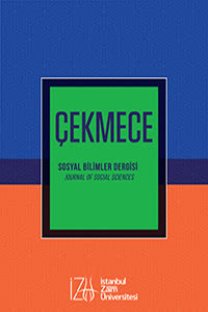TÜRK GENÇLERİNDE DİNİ VE İNFORMAL GÖNÜLLÜLÜK: BİR ÖLÇEK GELİŞTİRME ÇALIŞMASI
Öz Mevcut literatür Türkiye’de gönüllülüğün yetersizliğine hatta gerikalmışlığına vurgu yapar. Bu, Batı kaynaklı gönüllülük ölçeklerinin alandaki dominasyonuyla yakından ilgilidir. Oysa bu ölçekler Türk toplumunun kendine özgü durumunu yansıtmaktan aciz kalmaktadırlar. Ancak bu durum gönüllülüğü ölçme çabalarından vazgeçmeyi değil, Türkiye gerçeğine özgü bir ölçüm aracı geliştirmeyi gerektirir.
Anahtar Kelimeler:
Gönüllülük, Gönüllülük Ölçekleri, Dini Gönüllülük, İnformal Gönüllülük, kayıt-dışı gönüllülük
___
Anderson, J. C., & Gerbing, D. W. (1984). “The Effect of sampling Error on Convergence, Improper Solutions, and Goodness-of-fit indices for Maximum Likelihood Confirmatory Factor Analysis”. Psychometrika, 49, 155-173.Angermann, Annette & Sittermann, Birgit (2011). Volunteering in the Member States of the European Union - Evaluation and Summary of Current Studies. Working paper no. 5 of the Observatory for Sociopolitical Developments in Europe. http://www.sociopolitical-observatory.eu
Aydınlıgil, Seyhan. (2013). “Sosyal Politika Geliştirmede Yeni Bir Alan: Gönüllülük” Türkiye’de Gönüllülük: Gönüllülüğün Rolünün ve Katkılarının Keşfedilmesi. Yay. Haz.: Birleşmiş Milletler Gönüllüleri (UNV) programı Türkiye & GSM Gençlik Servisleri Merkezi Çev.: Bordo Tercüme Bürosu & Eda Erdem.
Betil, İbrahim. (2013). “Etkin Bir Sivil Toplum Yansıması Olarak Gönüllülük: Karşılaştığı Zorluklar ve Fırsatlar” Türkiye’de Gönüllülük: Gönüllülüğün Rolünün ve Katkılarının Keşfedilmesi. Yay. Haz.: Birleşmiş Milletler Gönüllüleri (UNV) programı Türkiye & GSM Gençlik Servisleri Merkezi Çev.: Bordo Tercüme Bürosu & Eda Erdem.
Bollen, K. A. (1989). Structural Equations with Latent Variables. New York: Wiley.
Bowen, Kurt (1999). Religion, Participation, and Charitable Giving: a report. Volunteer Canada & The Canadian Centre for Philanthropy.
Browne, M. W. & Cudeck, R. (1993). “Alternative ways of assessing model fit”. In: Bollen, K. A. &Long, J. S. (Eds.) Testing Structural Equation Models. pp. 136–162. Beverly Hills, CA: Sage
Büyüköztürk, Ş. (2006). Sosyal Bilimler İçin Veri Analizi: İstatistik, Araştırma Deseni SPSS Uygulamaları ve Yorum. Ankara: PegemA Yayıncılık
Choi, Namkee G. & DiNitto, Diana M.. (2012). “Predictors of Time Volunteering, Religious Giving, and Secular Giving: Implications for Nonprofit Organizations” Journal of Sociology & Social Welfare, Volume XXXIX, Number 2: 93-120.
Cnaan, R., Kasternakis, A., & Wineburg, R. (1993). “Religious people, religious congregations and volunteerism in human services: is there a link”', Nonprofit and Voluntary Sector Quarterly, 22 (1).
Çakı, Fahri (2014). “Türk Sosyolojisinde yeni bir Alan: Gönüllülük Araştırmaları” Sosyoloji Dergisi, 3. Dizi, 29. Sayı, 2014/2, s.185-202.
Ecklund E . H . & J erry Z . P ark (2007). “Religious Diversity and Community Volunteerism Among Asian Americans,” Journal for the Scientific Study of Religion 46(2):233–244
European Social Surveys – ESS http://www.europeansocialsurvey.org/ Gilles, Gignac, E.(2009). “Partial Confirmatory Factor Analysis: Described and Illustrated on the NEO-PIR”, Journal of Personality Assessment, 91: 1, 40 — 47
Hu, L., & Bentler, P. (1995). “Evaluating model fit.” In R. H. Hoyle (Ed.), Structural Equation modeling. Concepts, issues, and applications (pp. 76−99). London: Sage.
Independent Sector (2001). Giving and Volunteering in the United States, 2001.
International Labour Office (ILO) (2011). Manual on the measurement of volunteer work /. – Geneva.
Jackson, E., Bachmeier, M., Wood, J., & Craft, E. (1995). “Volunteering and charitable giving: do religious and associational ties promote helping behaviour?”, Nonprofit and Voluntary Sector Quarterly, 24 (1), Spring 1995.
Jöreskog, K. G., &Sörbom, D. (1989). LISREL 7 user's reference guide. Chicago: SPSS Publications.
Jöreskog, K.G., & Sorbom, D. (1996). LISREL 8 reference guide. Lincolnwood, IL: Scientific Software International.
Lukka, P., Locke M, & Soteri-Procter A. (2003). Faith and voluntary action: community, values and resources, Institute for Volunteering Research and Centre for Institutional Studies, School of Social Sciences, University of East London.
OECD Family Database (2009). CO4.1: Participation in voluntary work and membership of NGOs for young adults http://www.oecd.org/els/family/43200164.pdf Last updated 29/06/2009 (okuma tarihi: 22/10/2015).
Pires, Cesaltina; Prouteau, Lionel ve Sardinha, Boguslawa. (2010). “Rates of Participaiıon in Volunteering and Characteristics of Volunteers: European Comparısons” 9th International Conference of the International Society for Third- Sector Research, Istanbul – Turkey July 7-10, 2010.
Rose, Richard ve Ozcan, Yusuf. (2007). First European Quality of Life Survey: Quality of life in Turkey. European Foundation for the Improvement of Living and Working Conditions Luxembourg: Office for Official Publications of the European Communities. ISBN 978-92-897-0800-5
Seçer İ., Halmatov S., Gençdoğan, B. (2013). “Duygusal Tepkisellik Ölçeğinin Türkçeye Uyarlanması: Güvenirlik ve Geçerlilik Çalışması,” Sakarya University Journal of Education, 3/1 (Nisan /April 2013), ss. 77-89.
Sümer, N. (2000). “Yapısal eşitlik modelleri: Temel kavramlar ve örnek uygulama,” Türk Psikoloji Yazıları, Cilt 3, Sayı 6, 49-73.
Tabachnick, B. G. & Fidell, L. S. (2001). Using multivariate statistics (4th Ed). Needham Heights: Allyn& Bacon.
Taniguchi, Hiromi & Thomas, Leonard D. (2011). “The Influences of Religious Attitudes on Volunteering,” Voluntas (2011) 22:335–355.
Uslaner, E. (1997). Faith, Hope and Charity: social capital, trust and collective action, Department of Government and Politics, University of Maryland.
United Nations Volunteers (UNV) (2011). State of the World’s Volunteerism Report 2011. ISBN-13: 978-92-1-101246-0
Wilson, J. & Musick, M. (1997). “Who cares? Toward an integrated theory of volunteer work”. American Sociological Review, 62, 694-713.
World Values Surveys: http://www.worldvaluessurvey.org/
- Yayın Aralığı: Yılda 2 Sayı
- Yayıncı: İstanbul Sabahattin Zaim Üniversitesi
Sayıdaki Diğer Makaleler
AİDİYET VE MEKÂN OLARAK SOKAKLAR: BALIKESİR ÖRNEK OLAYI ÇERÇEVESİNDE BİR TİPOLOJİ ÖNERİSİ
IMAMS WITHOUT DISTRICT: CHANGING ROLES OF CONTEMPORARY MOSQUE OFFICIALS
SOSYAL ÇALIŞMA VE YÖNETİM ARASINDAKİ İLİŞKİNİN DEĞERLENDİRİLMESİ
Mehmet BİRİNCİ, Fatih ALTUN, Kaan SEVİM
TÜRK GENÇLERİNDE DİNİ VE İNFORMAL GÖNÜLLÜLÜK: BİR ÖLÇEK GELİŞTİRME ÇALIŞMASI
OSMANLI SUYOLLARI: DİYARBAKIR SUYOLLARININ VE ÇEŞMELERİNİN MAHALLE VE SOKAKLARA DAĞILIMI
SOKAK VE İDEOLOJİ: TÜRKİYE’DE RESMİ İDEOLOJİNİN SOKAK, CADDE, BULVAR VE MEYDANLARA YANSIMALARI
